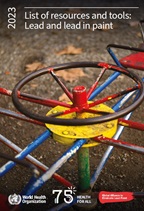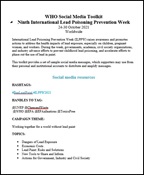
About
International Lead Poisoning Prevention Week, 25-31 October 2020
Children playing on swings at a playground. Playground equipment is often painted with lead paint. Deteriorating lead paint is a source of exposure to lead.
The issue
Lead is a well-recognized toxicant that has wide-ranging health impacts, in particular affecting the neurological, cardiovascular, gastrointestinal and haematological systems. Young children are particularly vulnerable because they have higher exposures than adults and because lead affects the developing brain, potentially resulting in reduced intellectual ability. The Institute for Health Metrics and Evaluation1 estimated that in 2017 lead exposure accounted for 1.06 million deaths and 24.4 million years lost to disability and death due to long-term health effects, with the highest burden in developing regions.
Even though there is wide recognition of the harmful effects of lead and many countries have taken action, exposure to lead, particularly in childhood, remains of key concern to health care providers and public health officials worldwide.
An important source of lead exposure, particularly in children, is paint containing high levels of lead. These paints are still widely available and used in many countries for decorative purposes, although good alternatives without added lead are available.
Policy background
Recognizing the continuing need for action to stop exposure to lead from paint, the second session of the International Conference on Chemicals Management in 2009 nominated lead in paint as an emerging policy issue for voluntary cooperative action for risk reduction by countries under the Strategic Approach to International Chemicals Management (SAICM) policy framework. This led to the establishment of the Global Alliance to Eliminate Lead Paint (the Lead Paint Alliance) in 2011, under the joint leadership of the United Nations Environment Programme (UNEP) and the World Health Organization (WHO). The primary goal of the Alliance is to promote the global phase-out of lead paint through the establishment of appropriate legally binding measures to stop the manufacture, import, export, distribution, sale and use of lead paints in every country. This goal has received further support in the WHO Road map to enhance health sector engagement in the Strategic Approach to International Chemicals Management towards the 2020 goal and beyond (decision WHA70(23)), which includes national action to phase out the use of lead paint.
The elimination of lead paint will contribute to the achievement of the following Sustainable Development Goal targets:
- 3.9: By 2030 substantially reduce the number of deaths and illnesses from hazardous chemicals and air, water, and soil pollution and contamination.
- 12.4: By 2020, achieve the environmentally sound management of chemicals and all wastes throughout their life cycle, in accordance with agreed international frameworks, and significantly reduce their release to air, water and soil in order to minimize their adverse impacts on human health and the environment.
The campaign
International lead poisoning prevention week (ILPPW) is an initiative of the Lead Paint Alliance. The aim of the week of action is to:
- raise awareness about health effects of lead exposure;
- highlight the efforts of countries and partners to prevent led exposure, particularly in children; and
- urge further action to eliminate lead paint through regulatory action at country level.
Governments, civil society organizations, health partners and others are encouraged to organize campaigns during ILPPW. A range of materials to support campaign activities have been developed by the Lead Paint Alliance and are made available by WHO. We invite campaign organizers to register their events on our webpage so that others can see what events are happening in their area.
Documents
/environment-climate-change-and-health-(ech)/chemical-safety-and-health-unit-(che)/list-of-resources-ilpw2024-thumb.tmb-144v.jpg?sfvrsn=8c15e6fa_2)
2024 List of resources and tools: Lead and lead in paint

2023 List of resources and tools: Lead and lead in paint
The International Lead Poisoning Prevention Week (ILPPW) takes place every year during the third week of October. The focus of this year’s week...

Social Media Toolkit - ILPPW2021
International Lead Poisoning Prevention Week (ILPPW) raises awareness and promotes actions to address the health impacts of lead exposure, especially on...
